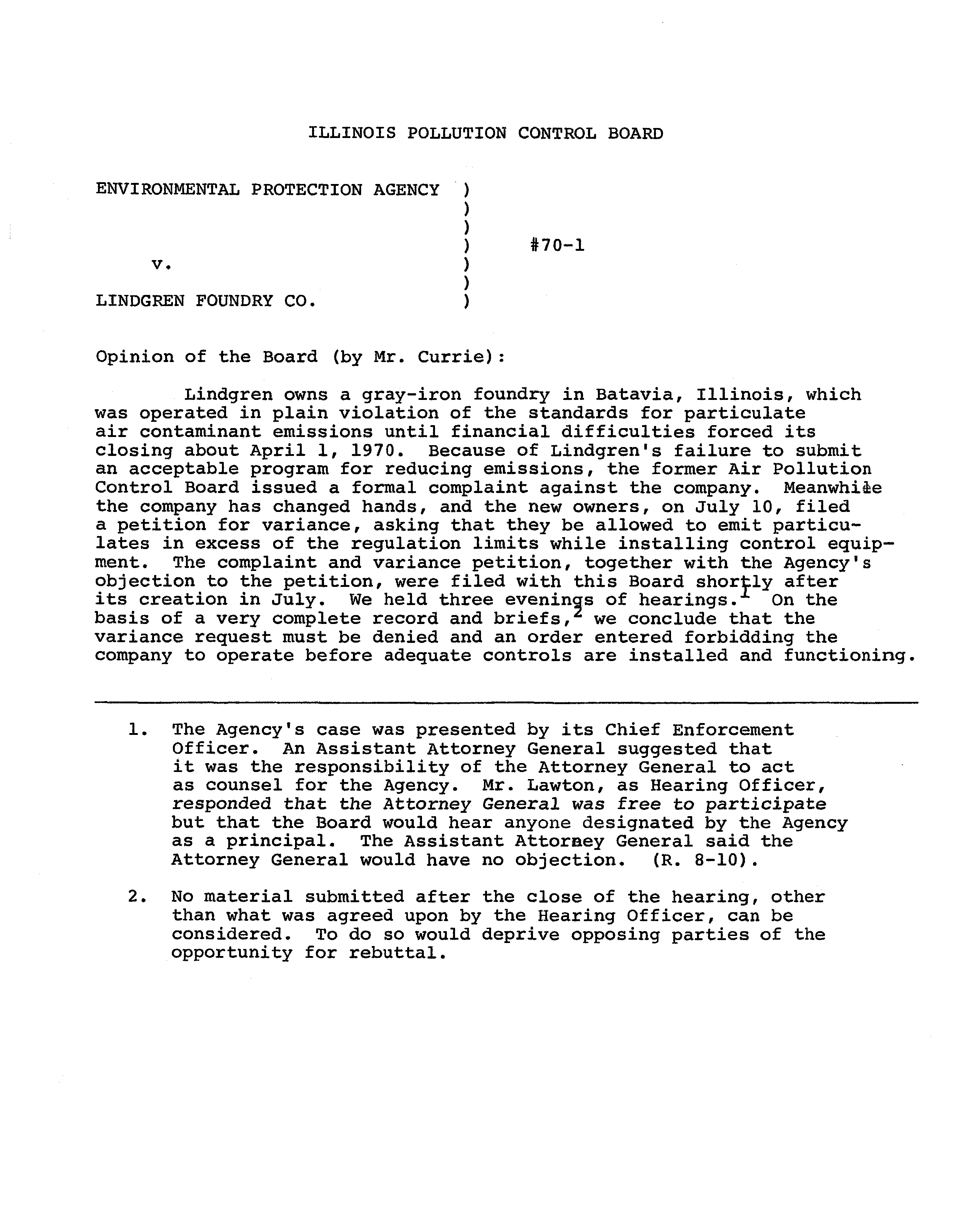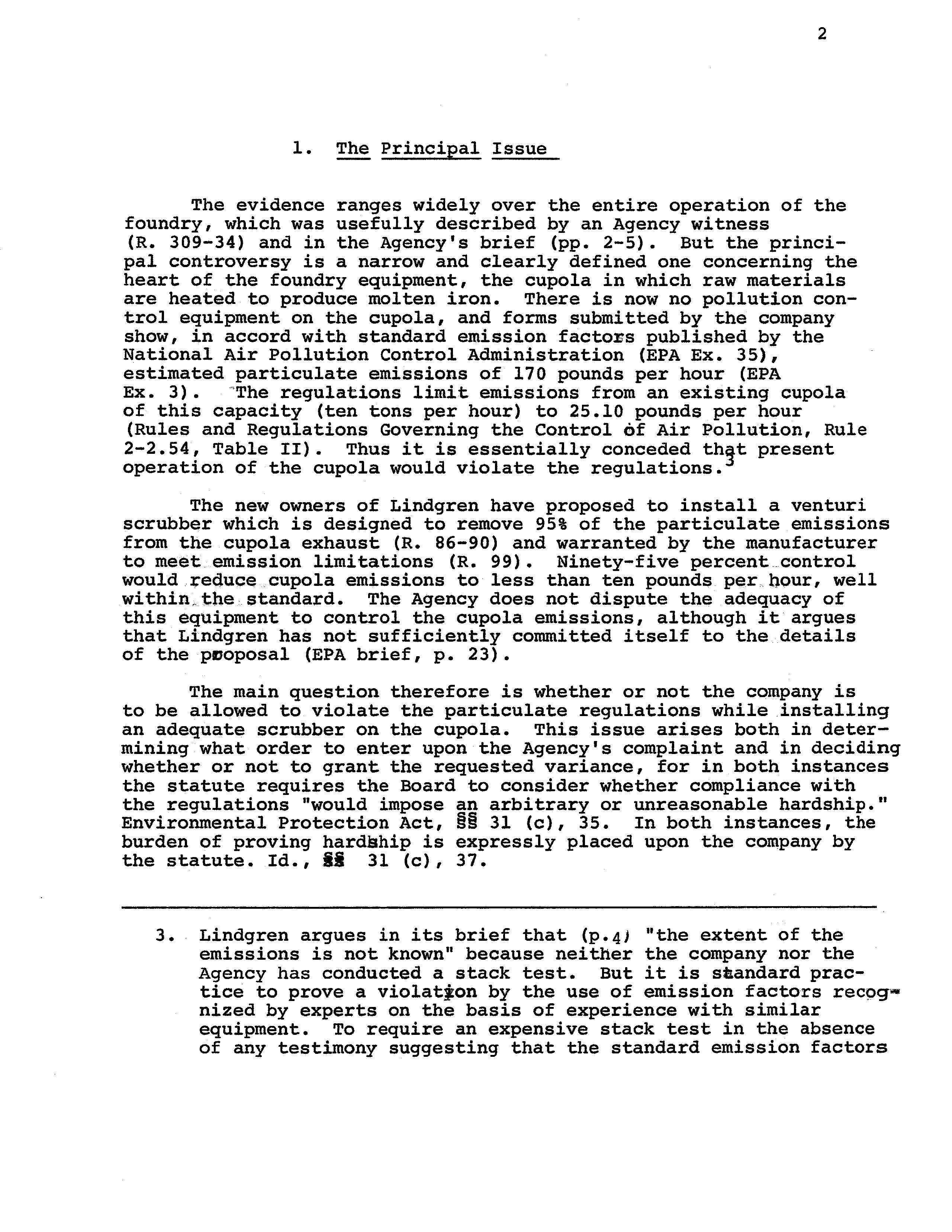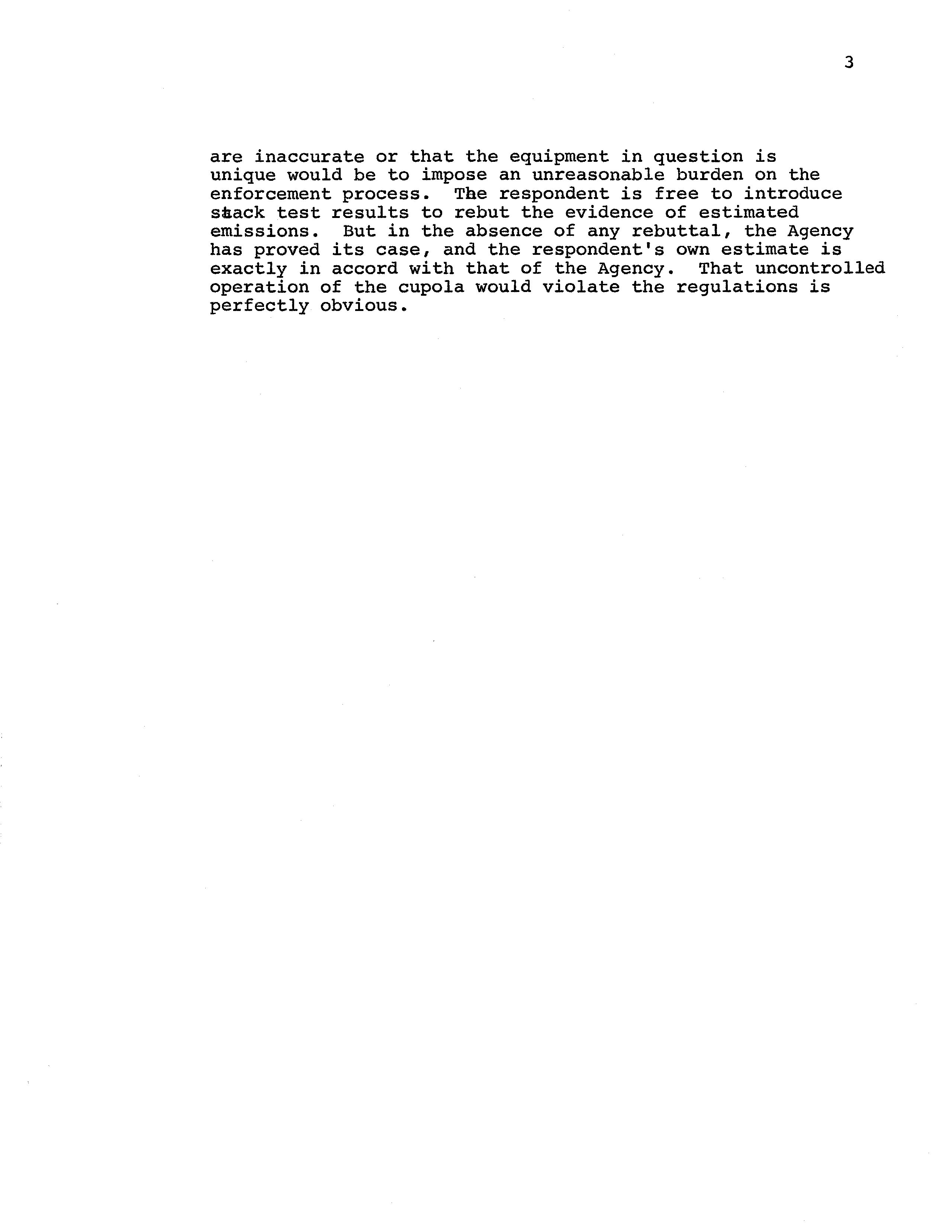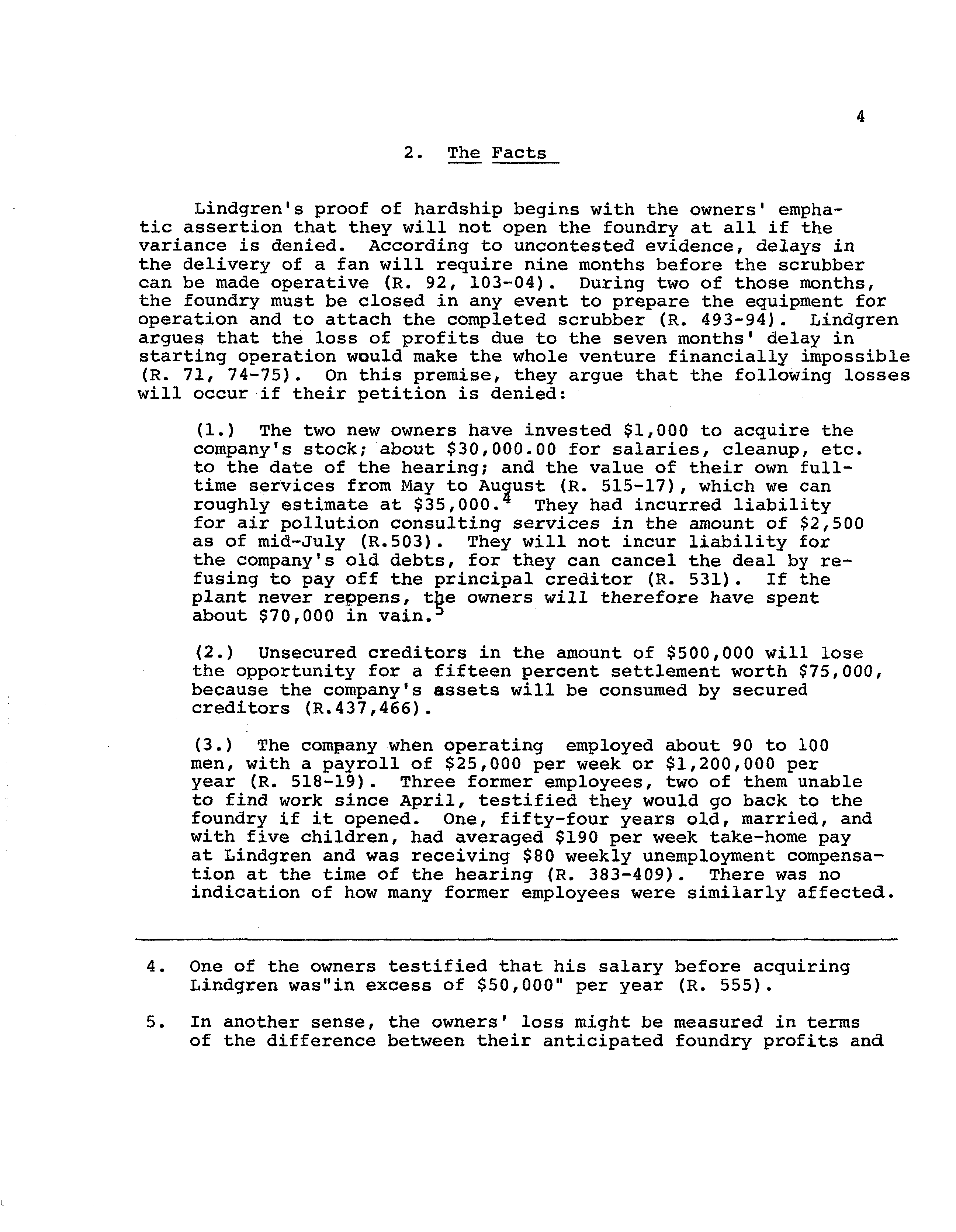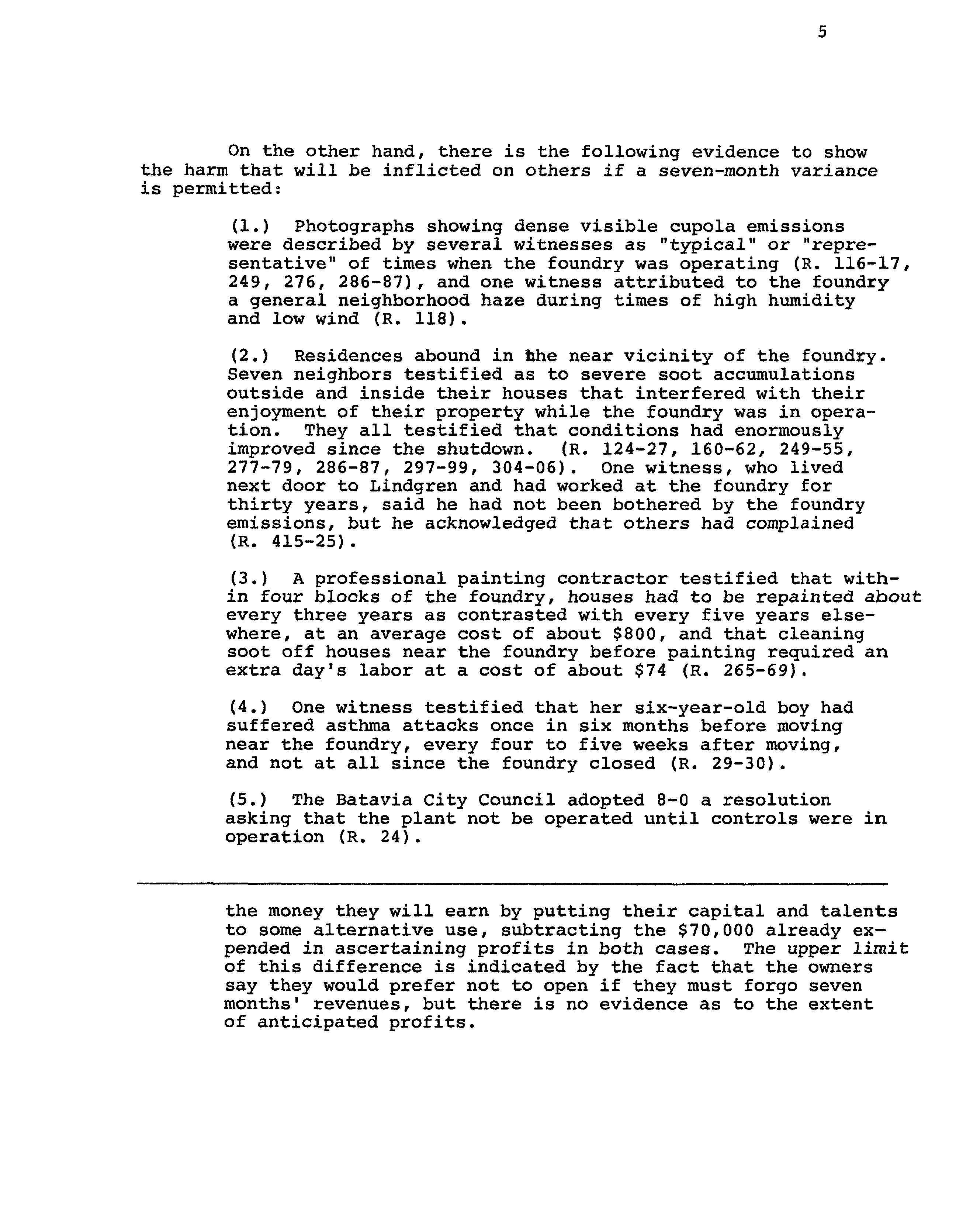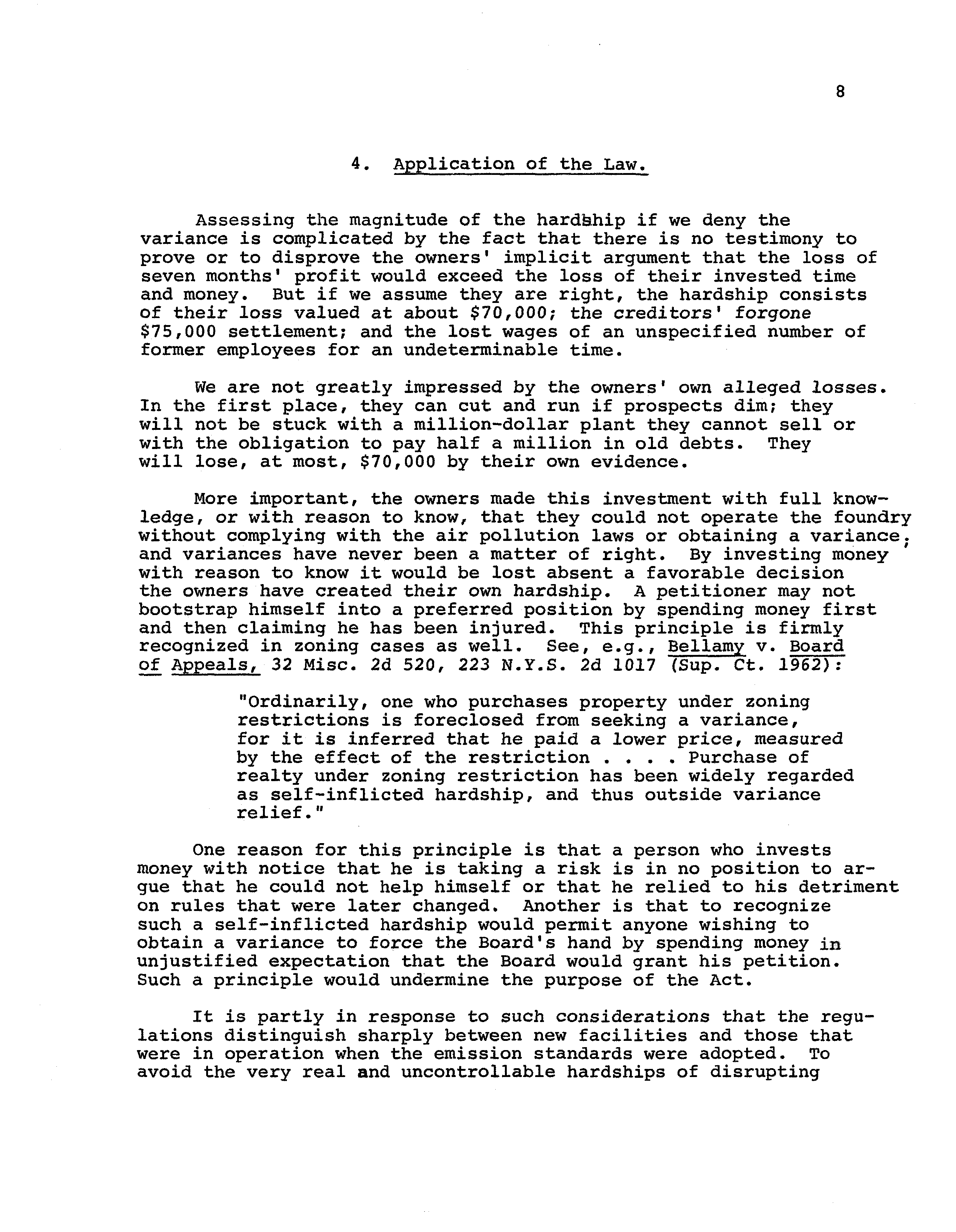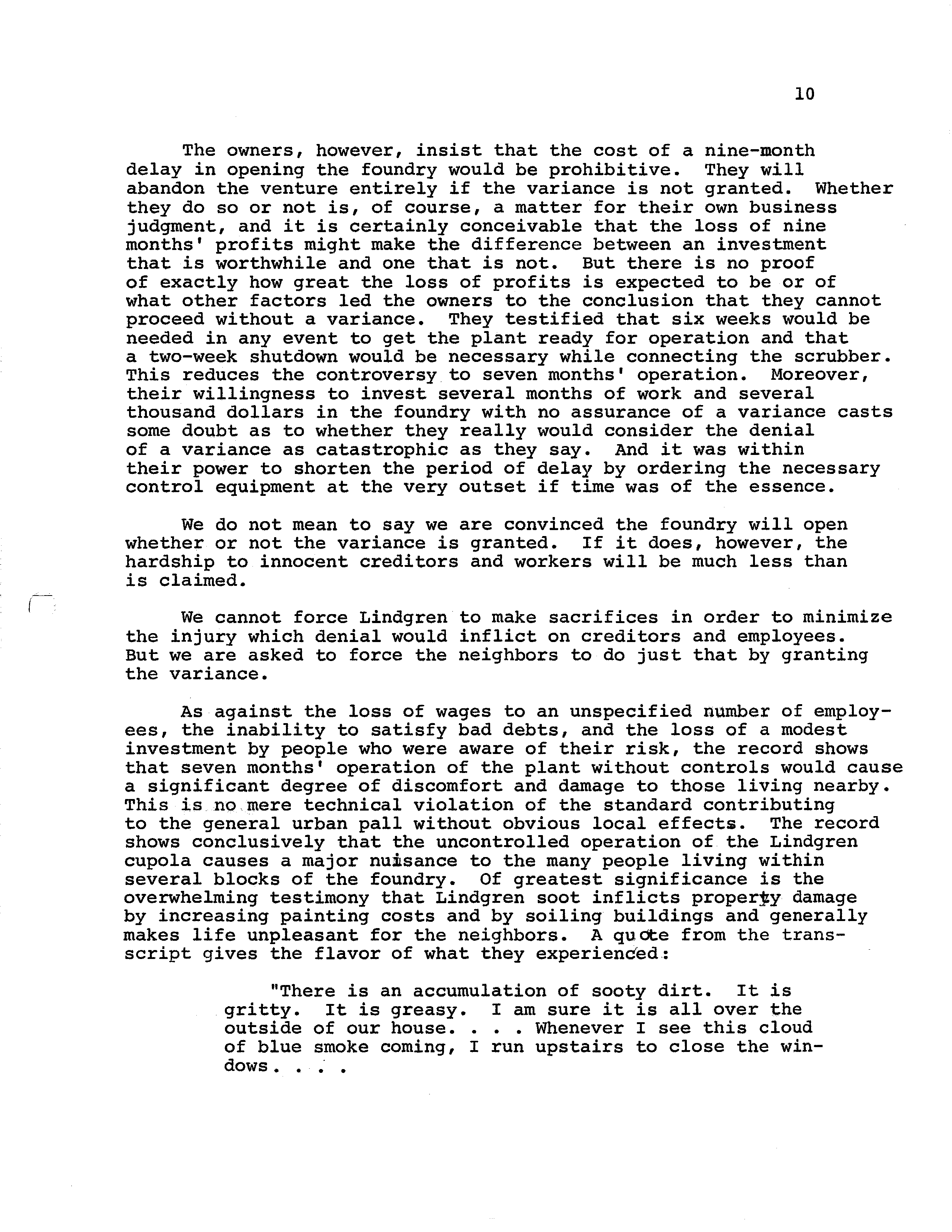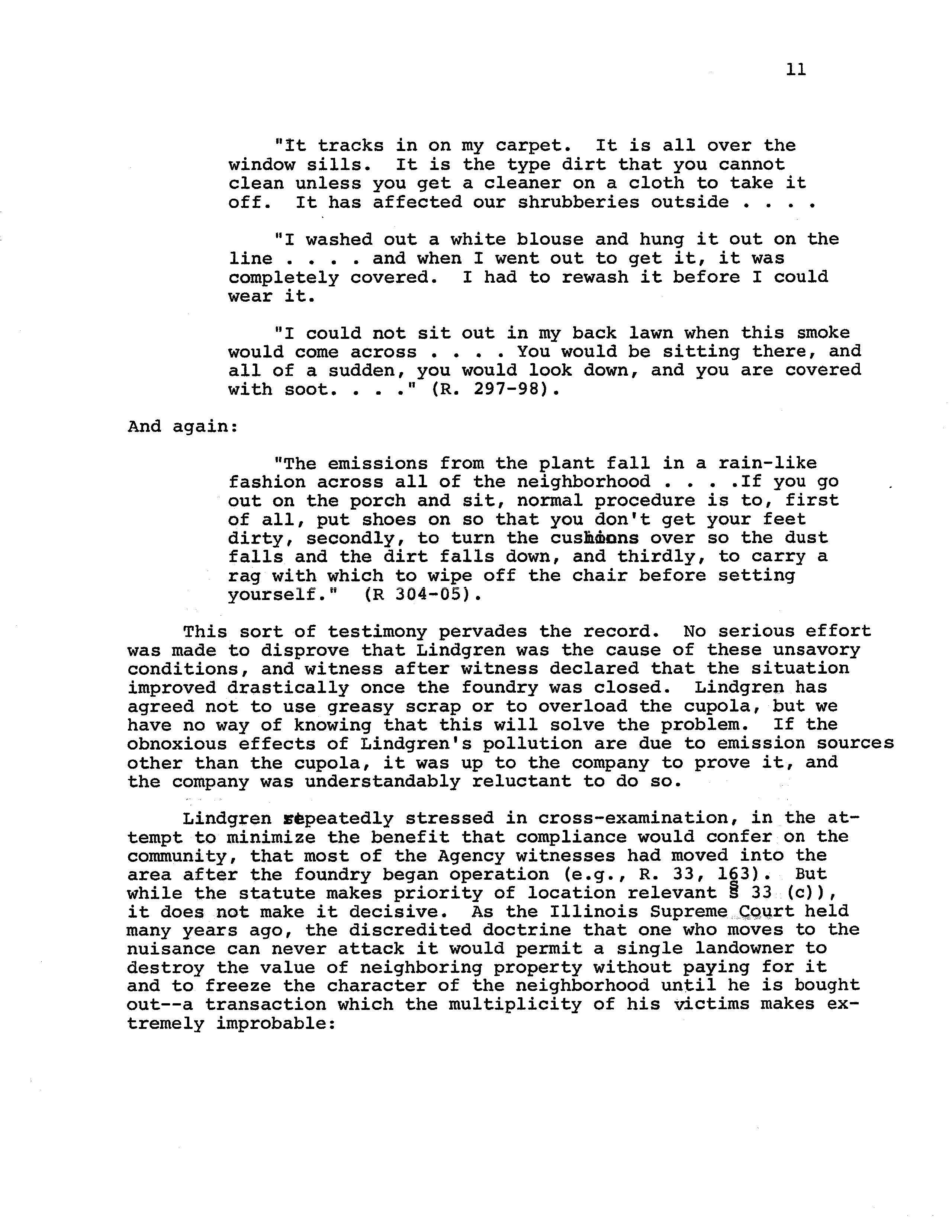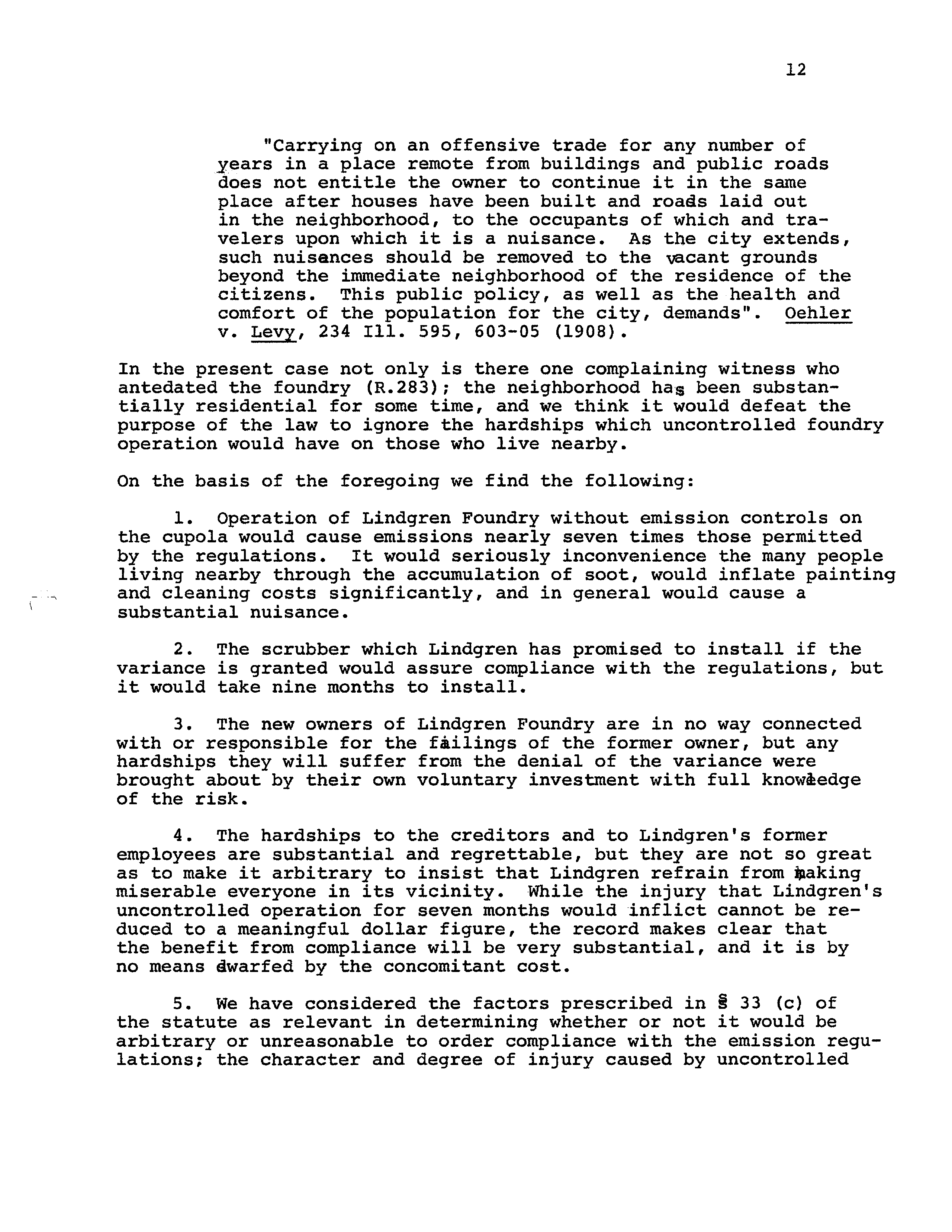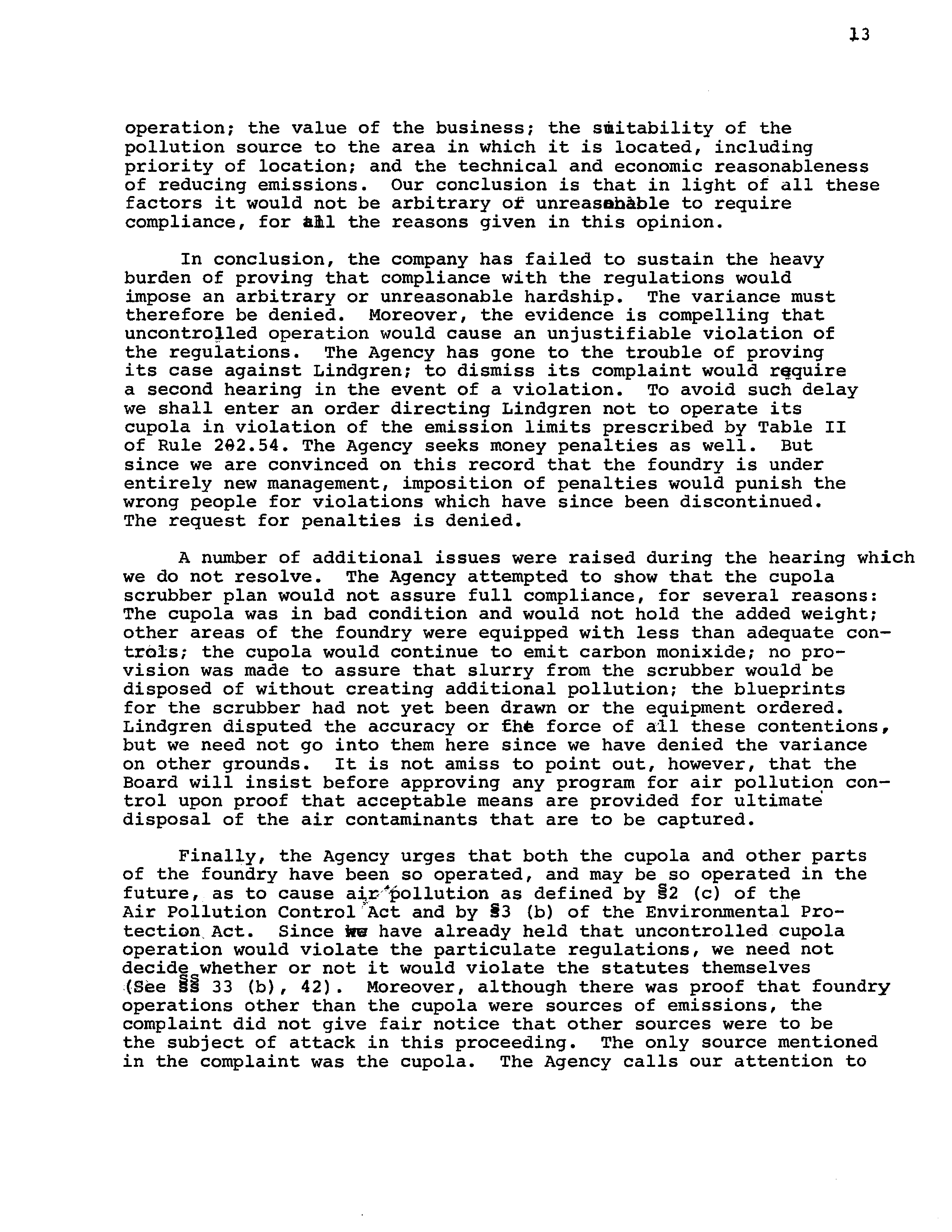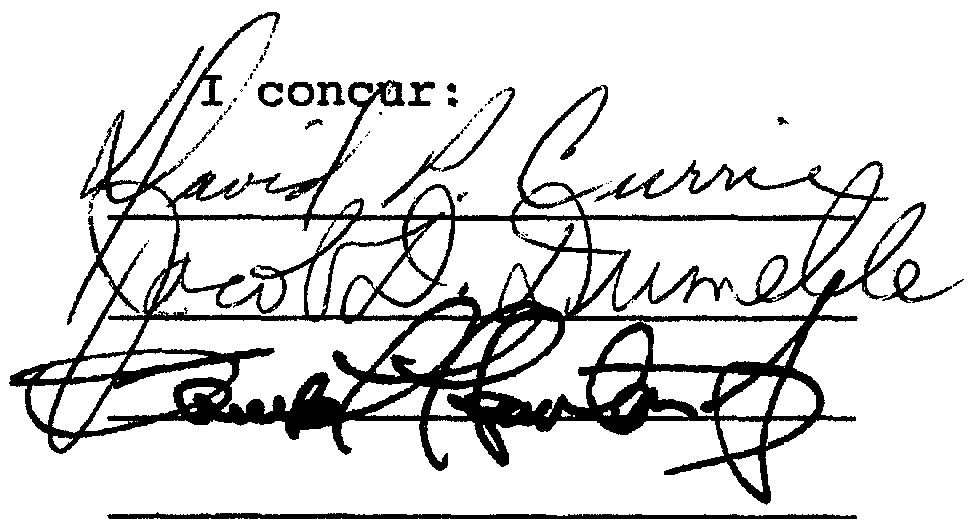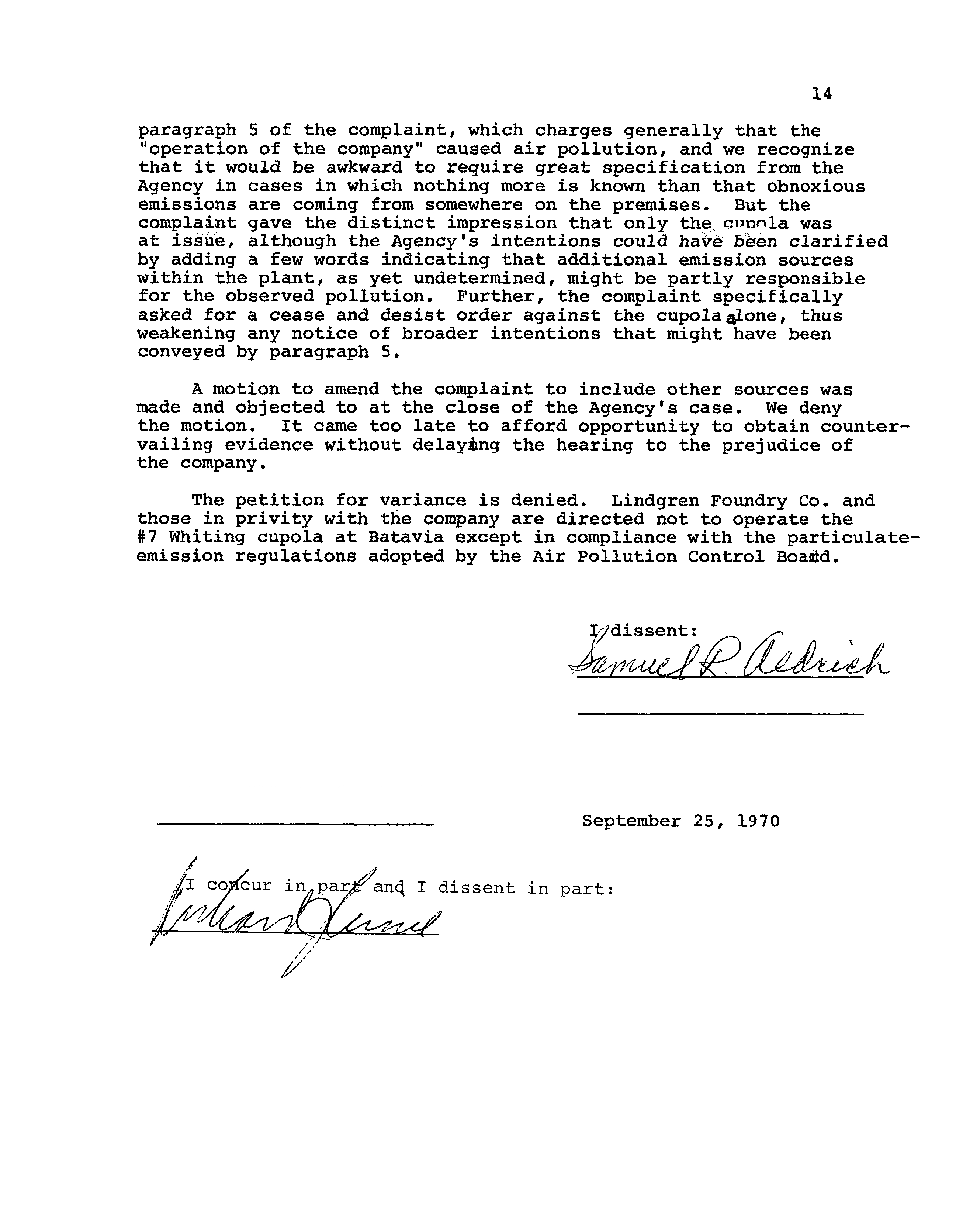ILLINOIS POLLUTION CONTROL BOARD
ENVIRONMENTAL PROTECTION AGENCY
)
)
#70—1
v.
)
LINDGREN FOUNDRY CO.
)
Opinion of the Board
(by Mr. Currie):
Lindgren owns a gray-iron foundry in Batavia, Illinois, which
was operated in plain violation of the standards for particulate
air contaminant emissions until financial difficulties forced its
closing about April
1, 1970.
Because of Lindgren’s failure to submit
an acceptable program for reducing emissions, the former Air Pollution
Control Board issued a formal complaint against the company.
Meanwhi&e
the company has changed hands,
and the new owners, on July 10, filed
a petition for variance, asking that they be allowed to emit particu-
lates in excess of the regulation limits while installing control equip-
ment.
The complaint and variance petition, together with the Agency’s
objection to the petition, were filed with this Board shortly after
its creation in July.
We held three evenings of hearings.
On the
basis of a very complete record and briefs,~we conclude that the
variance request must be denied and an order entered forbidding the
company to operate before adequate controls are installed and functioning.
1.
The Agency’s case was presented by its Chief Enforcement
Officer.
An Assistant Attorney General suggested that
it was the responsibility of the Attorney General to act
as counsel for the Agency.
Mr. Lawton, as Hearing Officer,
responded that the Attorney General was free to
participate
but that the Board would hear anyone designated by the Agency
as a principal.
The Assistant Attorney General said the
Attorney General would have no objection.
(R. 8-10).
2.
No material submitted after the close of the hearing, other
than what was agreed upon by the Hearing Officer,
can be
considered.
To do so would deprive opposing parties of the
opportunity for rebuttal.
2
1.
The Principal Issue
The evidence ranges widely over the entire operation of the
foundry, which was usefully described by an Agency witness
CR.
309-34) and in the Agency’s brief
(pp.
2-5).
But the princi-
pal controversy is a narrow and clearly defined one concerning the
heart of the foundry equipment, the cupola in which raw materials
are heated to produce molten iron.
There is now no pollution con-
trol equipment on the cupola, and forms submitted by the company
show,
in accord with standard emission factors published by the
National Air Pollution Control Administration
(EPA Ex. 35),
estimated particulate emissions of 170 pounds per hour
(EPA
Ex.
3).
~The regulations limit emissions from an existing cupola
of this capacity (ten tons per hour)
to 25.10 pounds per hour
(Rules and Regulations Governing the Control
of
Air Pollution, Rule
2-2.54, Table II).
Thus it is essentially conceded th~tpresent
operation of the cupola would violate the regulations.
The new owners of Lindgren have proposed to install a venturi
scrubber which is designed to remove 95
of the particulate emissions
from the cupola exhaust
(R. 86—90) and warranted by the manufacturer
to meet emission limitations
CR. 99).
Ninety-five percent.~control
would reduce cupola emissions to less than ten pounds~per.. hour, well
within~thestandard. The Agency does not dispute
the
adequacy of
this equipment to control the cupola emissions, although it argues
that Lindgren has not sufficiently committed itself to thedetails
of the pvoposal
(EPA brief, p. 23).
The main question therefore is whether or not the company is
to be allowed to violate the particulate regulations while installing
an adequate scrubber on the cupola.
This issue arises both in deter-
mining what order to enter upon the Agency’s complaint and in deciding
whether or not to grant the requested variance, for in both instances
the statute requires the Board to consider whether compliance with
the regulations “would impose an arbitrary or unreasonable hardship.”
Environmental Protection Act, ~
31
Cc),
35.
In both instances,
the
burden of proving hard~hipis expressly placed upon the company by
the statute. Id.,
ft
31
Cc), 37.
3.
Lindgren argues
in its brief that
(p.~ij “the extent of the
emissions is not known” because neither the company nor the
Agency has conducted a stack test.
But it is standard prac-
tice to prove a violat~tonby the use of emission factors rec~g~
nized by experts on the basis of experience with similar
equipment.
To require an expensive stack test in the absence
of any testimony suggesting that the standard emission factors
3
are inaccurate or that the equipment in question is
unique would be to impose an unreasonable burden on the
enforcement process.
The respondent is free to introduce
stack test results to rebut the evidence of estimated
emissions.
But in the absence of any rebuttal, the Agency
has proved its case, and the respondent’s own estimate is
exactly in accord with that of the Agency.
That uncontrolled
operation of the cupola would violate the regulations is
perfectly obvious.
4
2.
The Facts
Lindgren’s proof of hardship begins with the owners’ empha-
tic assertion that they will not open the foundry at all if the
variance
is denied.
According to uncontested evidence, delays in
the delivery of a fan will require nine months before the scrubber
can be made operative
(R.
92,
103-04).
During two of those months,
the foundry must be closed in any event to prepare the equipment for
operation and to attach the completed scrubber
(R.
493-94).
Lindgren
argues that the loss of profits due to the seven months’ delay in
starting operation would make the whole venture financially impossible
CR.
71, 74-75).
On this premise,
they argue that the following losses
will occur if their petition is denied:
(1.)
The two new owners have invested $1,000 to acquire the
company’s stock; about $30,000.00 for salaries,
cleanup, etc.
to the date of the hearing; and the value of their own full-
time services from May to Auc~ust (R.
515-17), which we can
roughly estimate at $35,000.’*
They had incurred liability
for air pollution consulting services in the amount of $2,500
as of mid-July (R.503).
They will not incur liability for
the company’s old debts, for they can cancel the deal by re-
fusing to pay off the principal creditor
(R. 531).
If the
plant never reppens, t~eowners will therefore have spent
about $70,000 in vain.
(2.)
Unsecured creditors in the amount of $500,000 will lose
the opportunity for a fifteen percent settlement worth $75,000,
because the company’s assets will be consumed by secured
creditors
(R.437,466).
(3.)
The company when operating
employed about 90 to 100
men, with a payroll of $25,000 per week or $1,200,000 per
year
CR.
518-19).
Three former employees, two of them unable
to find work since April, testified they would go back to the
foundry if it opened.
One, fifty-four years old, married, and
with five children, had averaged $190 per week take-home pay
at Lindgren and was receiving $80 weekly unemployment compensa-
tion at the time of the hearing
(R. 383-409).
There was no
indication of how many former employees were similarly affected.
4.
One of the owners testified that his salary before acquiring
Lindgren was”in excess of $50,000” per year
(R.
555).
5.
In another sense, the owners’ loss might be measured in terms
of the difference between their anticipated foundry profits and
5
On the other hand, there is the following evidence to show
the harm that will be inflicted on others if a seven-month variance
is permitted:
(1.)
Photographs showing dense visible cupola emissions
were described by several witnesses as
“typical” or
“repre-
sentative” of times when the foundry was operating
(R. 116-17,
249, 276,
286-87), and one witness attributed to the foundry
a general neighborhood haze during times of high humidity
and low wind
(R. 118).
(2.)
Residences abound in the near vicinity of the foundry.
Seven neighbors testified as to severe soot accumulations
outside and inside their houses that interfered with their
enjoyment of their property while the foundry was in opera-
tion.
They all testified that conditions had enormously
improved since the shutdown.
CR. 124—27, 160—62, 249—55,
277—79,
286—87, 297—99,
304—06).
One witness, who lived
next door to Lindgren and had worked at the foundry for
thirty years, said he had not been bothered by the foundry
emissions, but he acknowledged that others had complained
CR.
415—25)
(3.)
A professional painting contractor testified that with-
in four blocks of the foundry, houses had to be repainted about
every three years as contrasted with every five years else-
where, at an average cost of about $800, and that cleaning
soot off houses near the foundry before painting required an
extra day’s
labor at a cost of about $74
(R.
265—69).
(4.)
One witness testified that her six-year-old boy had
suffered asthma attacks once in six months before moving
near the foundry, every four to five weeks after moving,
and not at all since the foundry closed
(R.
29-30).
(5.)
The Batavia City Council adopted 8—0 a resolution
asking that the plant not be operated until controls were in
operation
(R.
24).
the money they will earn by putting their capital and talents
to some alternative use, subtracting the $70,000 already ex-
pended in ascertaining profits in both cases.
The upper limit
of this difference is indicated by the fact that the owners
say they would prefer not to open if they must forgo seven
months’ revenues, but there is no evidence as to the extent
of anticipated profits.
6
3,
The Law
The question before us is whether or not, on these
facts,
the hardship imposed by refusing the variance so far outweights the
benefits to the community as to be “arbitrary or unreasonable.”
That denial of the variance would inflict some financial hard-
ship on the company and on others is clear.
But if a variance were
granted every time it cost money to comply with the pollution laws,
nearly everybody would qualify.
The statute requires us all to make
sacrifices for the common good.
It allows relief only when the
sacrifice is unreasonable when compared with the benefits it produces.
That the new owners in good faith propose to bring the cupola
into compliance with the law is also clear.
But while a good faith
effort to reduce emissions is a necessary condition for a variance
(Swords—v. Environmental Protection Agency,
#70—6), it is not a
sufficient one.
Permission to violate the law while making correc-
tions cannot be granted automatically.
In general, people may
not drive until after their brakes have been repaired, and similarly,
they may not operate cupolas until after emission controls are func-
tioning unless the cost of the delay is unreasonable when compared
with the benefits.
It is therefore essential in passing upon a variance petition
to compare the good effects of compliance with the bad.
But, as
we held in the Swords case,
supra, one cannot show that his hard-
ship is “arbitrary” or “unreasonable” merely by proving that the
cost of compliance exceeds the benefits.
The words “unreasonable” and “arbitrary” plainly suggest that
the Board is not to examine in every case whether or not compliance
would be a good thing.
To do so would completely destroy the force
of the regulations and encourage excessive litigation.
Moreover,
if the costs and benefits are anywhere near equal, simple fairness
dictates that the burden should be borne by those who profit from
the polluting operation rather than by the innocent neighbors.
Accordingly, the statute creates a strong presumption in favor of
compliance.
A variance is to be granted only in those extraordinary
situations in which the cost of compliance is wholly disproportionate
to the benefits; doubts are to be resolved in favor of denial.
This position is compellingly supported by legislative history
as well as by the language and policy of the Act.
The original ver-
sion of the bill provided for variances only if the costs of compliance
“totally dwarf(ed)” the benefits.
A proposed amendment sponsored by
industry would have weakened this to allow variances whenever costs
“outweigh(ed)” benefits.
The Administration spokesman for the bill
stressed before the Senate that this proposal was wholly unacceptable,
for reasons indicated in this opinion.
7
When~.thepresent language was proposed as a third alterna-
tive, the Administration assured the Senate that the change
preserved the substance of the original bill, and on this assurance
the amendment was adopted.
It is clear that the change was prompted
by uncertainty concerning the interpretation of the unfamiliar
phrase “totally dwarf.”
The chosen terms”arbitrary” and “unreasonab~e”
have a more established meaning, and they express a plain sense of
disproportion.
“Arbitrary” and “unreasonable” are words used to express great
deference and reluctance to interfere.
They are words used to
describe the limited~scopeof review of a jury’s findings or of
a judge’s exercise of discretion.
They are words used to describe
the limited power of a court to set aside a statute on the ground
it takes property without due process of law.
The Agency asks us to construe the words “arbitrary” and
“unreasonable” in the variance section to require a showing that
the denial of the petition would constitute a deprivation of property
without due process of law.
There is precedent for such a holding
both in zoning cases, see Mandelker, Managing Our Urban Environment
762
(1966),
and in the interpretation of the Illinois Air Pollution
Control Act, predecessor to the present statute.
Neal Auto Salvage,
Inc.
#VR 69—23
(Feb.
25,
1970).
It is not necessary on the present facts to decide whether
the
variance test of the Environmental Protection Act is a constitutional
test.
For it is clear that in any event there must be a showing
that the cost of compliance is wholly disproportionate to the benefits,
and we are persuaded that Lindgren has failed to make this showing.
We will face the further question if we encounter a case in which
we believe the cost is wholly disproportionate but in which to
require compliance would not be unconstitutional.
8
4.
Application of the Law.
Assessing the magnitude of the hardbhip if we deny the
variance is complicated by the fact that there is no testimony to
prove or to disprove the owners’ implicit argument that the loss of
seven months’ profit would exceed the loss of their invested time
and money.
But if we assume they are right, the hardship consists
of their loss valued at about $70,000;
the creditors’ forgone
$75,000 settlement;
and the lost wages of an unspecified number of
former employees for an undeterminable time.
We are not greatly impressed by the owners’ own alleged losses.
In the first place, they can cut and run if prospects dim; they
will not be stuck with a million—dollar plant they cannot sell or
with the obligation to pay half a million in old debts.
They
will lose,
at most, $70,000 by their own evidence.
More important, the owners made this investment with full know-
ledge, or with reason to know,
that they could not operate the foundry
without complying with the air pollution laws or obtaining a variance;
and variances have never been a matter of right.
By investing money
with reason to know it would be lost absent a favorable decision
the owners have created their own hardship.
A petitioner may not
bootstrap himself into a preferred position by spending money first
and then claiming he has been injured.
This principle is firmly
recognized in zoning cases as well.
See, e.g., Bellamy v.
Board
of Appeals,
32 Misc.
2d 520, 223 N.Y.S.
2d 1017
(Sup.
Ct.
1962):
“Ordinarily, one who purchases property under zoning
restrictions is foreclosed from seeking a variance,
for it is inferred that he paid a lower price, measured
by the effect of the restriction
.
.
.
.
Purchase of
realty under zoning restriction has been widely regarded
as self—inflicted hardship, and thus outside variance
relief.”
One reason for this principle is that a person who invests
money with notice that he is taking a risk is in no position to ar-
gue that he could not help himself or that he relied to his detriment
on rules that were later changed.
Another is that to recognize
such a self-inflicted hardship would permit anyone wishing to
obtain a variance to force the Board’s hand by spending money in
unjustified expectation that the Board would grant his petition.
Such a principle would undermine the purpose of the Act.
It is partly in response to such considerations that the regu—
lations distinguish sharply between new facilities and those that
were in operation when the emission standards were adopted.
To
avoid the very real and uncontrollable hardships of disrupting
9
existing businesses that had been constructed and operated
in legitimate reliance on the absence of emission limitations,
the
rules allowed businesses d?n operation a grace period in which
to achieve compliance.
But the owners of new facilities were in
complete control of whether or not they invested funds in polluting
equipment.
Their hardships were avoidable, and consequently new
facilities were required to comply with emission limitations before
they began operation.
See Rules and Regulations Governing the Control
of Air Pollution 2-2.12, 2-2.fl,2~2.4l. While the Lindgren Foundry
was in operation at the time the regulations were adopted in 1967,
the grace period for filing a program for delayed compliance expired
in 1968.
And in terms of the policy distinguishing existing and new
businesses in the regulations, the new Lindgren owners are in the
position of running a new business, for their entire investment was
made after the emission rules took effect.
As one of them enthusias-
tically affirmed during the hearing, the present foundry project is
“An entirely new ballgame”
(R. 36).
We have much more sympathy for the plight of Lindgren’s credi-
tors, who~willlose $75,000 if the foundry does not ope~,.~and
for the
unfortunate former employees who cannot find comparable work else-
where.
The extent of the workers’ misfortune cannot be determined
from the record,
for we know neither how many people are in this
position nor how long they will remain unemployed.
We also recog-
nize that their suffering cannot be measured solely in terms of
dollars.
The strongest argument for Lindgren is that by putting the neigh-
bors to a temporary inconvenience, we can help to create a viable
business that will improve the situation of creditors and former
employees and confer permanent benefits on the entire community.
But it should be borne in mind that tha:~:hardkhipsto the creditors
and to the workers would be significantly reduced if the owners
would install the scrubber first and then open their foundry.
For
there are
two
ways to reach the desired goal, which is that nine
months from now Lindgren will be in operation in compliance with
the emission limits.
To open the foundry before installing the
scrubber would place the burden of a less than optimum interim situa-
tion on the neighbors;
to delay opening until after installation
would place it on L~hndgren’sowners, employees, and creditors.
The people who live near the foundry are not responsible for the
workers’ plight; it can seldom be fair to ask them to bear the cost
of al&eviating unemployment.
Simple fairness dictates that any
hardships should be borne by those who will benefit from the opera-
tion of the foundry unless the harm to the neighbors
is quite small
in comparison.
10
The owners, however, insist that the cost of a nine-month
delay in opening the foundry would be prohibitive.
They will
abandon the venture entirely if the variance is not granted.
Whether
they do so or not is, of course,
a matter for their own business
judgment, and it is certainly conceivable that the loss of nine
months’ profits might make the difference between an investment
that is worthwhile and one that is not.
But there is no proof
of exactly how great the loss of profits is expected to be or of
what other factors led the owners to the conclusion that they cannot
proceed without a variance.
They testified that six weeks would be
needed in any event to get the plant ready for operation and that
a two—week shutdown would be necessary while connecting the scrubber.
This reduces the controversy to seven months’ operation.
Moreover,
their willingness to invest several months of work and several
thousand dollars in the foundry with no assurance of a variance casts
some doubt as to whether they really would consider the denial
of a variance as catastrophic as they say.
And it was within
their power to shorten the period of delay by ordering the necessary
control equipment at the very outset if time was of the essence.
We do not mean to say we are convinced the foundry will open
whether or not the variance is granted.
If it does, however, the
hardship to innocent creditors and workers will be much less than
is claimed.
We cannot force Lindgrento make sacrifices in order to minimize
the injury which denial would inflict on creditors and employees.
But we are asked to force the neighbors to do just that by granting
the variance.
As against the loss of wages to an unspecified number of employ-
ees, the inability to satisfy bad debts, and the loss of a modest
investment by people who were aware of their risk, the record shows
that seven months’
operation of the plant without controls would cause
a significant degree of discomfort and damage to those living nearby.
This is nomere technical violation of the standard contributing
to the general urban pall without obvious local effects.
The record
shows conclusively that the uncontrolled operation of the Lindgren
cupola causes a major nuisance to the many people living within
several blocks of the foundry.
Of greatest significance is the
overwhelming testimony that Lindgren soot inflicts properjzy damage
by increasing painting costs and by soiling buildings and generally
makes life unpleasant for the neighbors.
A qubte from the trans-
script gives the flavor of what they experienced.:
“There is an accumulation of sooty dirt.
It is
gritty.
It is greasy.
I am sure it is all over the
outside of our house.
.
.
.
Whenever I see this cloud
of blue smoke coming,
I run upstairs to close the win-
dows.
..
11
“It tracks in on my carpet.
It is all over the
window sills.
It is the type dirt that you cannot
clean unless you get a cleaner on a cloth to take it
off.
It has affected our shrubberies outside
.
.
“I washed out a white blouse and hung it out on the
line
.
.
.
.
and when
I went out to get it, it was
completely covered.
I had to rewash it before
I could
wear it.
“I could not sit out in my back lawn when this smoke
would come across
.
.
.
.
You would be sitting there, and
all of a sudden, you would look down, and you are covered
with soot.
.
.
.“
(R.
297—98).
And again:
“The emissions from the plant fall in a rain-like
fashion across all of the neighborhood
.
.
.
.If you go
out on the porch and sit, normal procedure is to,
first
of all, put shoes on so that you don’t get your feet
dirty, secondly, to turn the cusI~bonsover so the dust
falls and the dirt falls down, and thirdly,
to carry a
rag with which to wipe off the chair before setting
yourself.”
(R 304—05).
This sort of testimony pervades the record.
No serious effort
was made to disprove that Lindgren was the cause of these unsavory
conditions, and witness after witness declared that the situation
improved drastically once the foundry was closed.
Lindgren has
agreed not to use greasy scrap or to overload the cupola, but we
have no way of knowing that this will solve the problem.
If the
obnoxious effects of Lindgren’s pollution are due to emission sources
other than the cupola,
it was up to the company to prove it, and
the company was understandably reluctant to do so.
Lindgren repeatedly stressed in cross-examination, in the at-
tempt to minimize the benefit that compliance would confer on the
community, that most of the Agency witnesses had moved into the
area after the foundry began operation
(e.g.,
R.
33, 163).
But
while the statute makes priority of location relevant ~ 33
Cc)),
it does not make it decisive.
As the Illinois Supreme qc.~rtheld
many years ago, the discredited doctrine that one who moves to the
nuisance can never attack it would permit a single landowner to
destroy the value of neighboring property without paying for it
and to freeze the character of the neighborhood until he is bought
out--a transaction which the multiplicity of his victims makes ex-
tremely improbable:
12
“Carrying on an offensive trade for any number of
years in a place remote from buildings and public roads
does not entitle the owner to continue it in the same
place after houses have been built and roads laid out
in the neighborhood, to the occupants of which and tra-
velers upon which it is a nuisance.
As the city extends,
such nuisances should be removed to the
vacant grounds
beyond the immediate neighborhood of the residence of the
citizens.
This public policy,
as well as the health and
comfort of the population for the city, demands”.
Oehler
v. Levy,
234 Ill.
595, 603—05
(1908).
In the present case not only is there one complaining witness who
antedated the foundry
CR.283); the neighborhood has been substan-
tially residential for some time,
and we think it would defeat the
purpose of the law to ignore the hardships which uncontrolled foundry
operation would have on those who live nearby.
On the basis of the foregoing we find the following:
1.
Operation of Lindgren Foundry without emission controls on
the cupola would cause emissions nearly seven times those permitted
by the regulations.
It would seriously inconvenience the many people
living nearby through the accumulation of soot, would inflate painting
and cleaning costs significantly, and in general would cause
a
substantial nuisance.
2.
The scrubber which Lindgren has promised to install if the
variance is granted would assure compliance with the regulations, but
it would take nine months to install.
3.
The new owners of Lindgren Foundry are in no way connected
with or responsible for the failings of the former owner, but any
hardships they will suffer from the denial of the variance were
brought about by their own voluntary investment with full know&edge
of the risk.
4.
The hardships to the creditors and to Lindgren’s former
employees are substantial and regrettable, but they are not so great
as to make it arbitrary to insist that Lindgren refrain from baking
miserable everyone in its vicinity.
While the injury that Liridgren’s
uncontrolled operation for seven months would inflict cannot be re-
duced to a meaningful dollar figure, the record makes clear that
the benefit from compliance will be very substantial, and it is by
no means dwarfed by the concomitant cost.
5.
We have considered the factors prescribed in ~ 33
(C)
of
the statute as relevant in determining whether or not it would be
arbitrary or unreasonable to order compliance with the emission regu-
lations;
the character and degree of injury caused by uncontrolled
3.3
operation; the value of the business; the smitability of the
pollution source to the area in which it is located, including
priority of location;
and the technical and economic reasonableness
of reducing emissions.
Our conclusion is that in light of all these
factors it would not be arbitrary of unreasohàble to require
compliance, for tB~.l the reasons given in this opinion.
In conclusion, the company has failed to sustain the heavy
burden of proving that compliance with the regulations would
impose an arbitrary or unreasonable hardship.
The variance must
therefore be denied.
Moreover, the evidence is compelling that
uncontrolled operation would cause an unjustifiable violation of
the regulations.
The Agency has gone to the trouble of proving
its case against Lindgren; to dismiss its complaint would rqquire
a second hearing in the event of a violation.
To avoid such delay
we shall enter an order directing Lindgren not to operate its
cupola in violation of the emission limits prescribed by Table II
of Rule 2~2.54.The Agency seeks money penalties as well.
But
since we are convinced on this record that the foundry is under
entirely new management, imposition of penalties would punish the
wrong people for violations which have since been discontinued.
The request for penalties is denied.
A number of additional issues were raised during the hearing which
we do not resolve.
The Agency attempted to show that the cupola
scrubber plan would not assure full compliance,
for several reasons:
The cupola was in bad condition and would not hold the added weight;
other areas of the foundry were equipped with less than adequate con-
trOls; the cupola would continue to emit carbon monixide; no pro-
vision was made to assure that slurry from the scrubber would be
disposed of without creating additional pollution; the blueprints
for the scrubber had not yet been drawn or the equipment ordered.
Lindgren disputed the accuracy or th~force of all these contentions,
but we need not go into them here since we have denied the variance
on other grounds.
It is not amiss
to point out, however, that the
Board will insist before approving any program for air pollution con-
trol upon proof that acceptable means are provided for ultimate
disposal of the air contaminants that are to be captured.
Finally,
the Agency urges that both the cupola and other parts
of the foundry have been so operated, and may be so operated in the
future,
as to cause ajr~ollutionas defined by ~2
(c)
of the
Air Pollution ControlAct and by ~3
(b)
of the Environmental Pro-
tection Act.
Since ~e have already held that uncontrolled cupola
operation would violate the particulate regulations, we need not
decide whether or not it would violate the statutes themselves
(See ~
33
(b), 42).
Moreover, although there was proof that foundry
operations other than the cupola were sources of emissions,
the
complaint did not give fair notice that other sources were to be
the subject of attack in this proceeding.
The only source mentioned
in the complaint was the cupola.
The Agency calls our attention to
14
paragraph
5 of the complaint, which charges generally that the
“operation of the company” caused air pollution, and we recognize
that it would be awkward to require great specification from the
Agency in cases in which nothing more is known than that obnoxious
emissions are coming from somewhere on the premises.
But the
complaint.gave the distinct impression that only the. cunmla was
at issue, although the Agency’s intentions could have b’è~en clarified
by adding a few words indicating that additional emission sources
within the plant, as yet undetermined, might be partly responsible
for the observed pollution.
Further,
the complaint specifically
asked for a cease and desist order against the cupola~lone,thus
weakening any notice of broader intentions that might have been
conveyed by paragraph 5.
A motion to amend the complaint to include other sources was
made and objected to at the close of the Agency’s case.
We deny
the motion.
It came too late to afford opportunity to obtain counter-
vailing evidence without delaying the hearing to the prejudice of
the company.
The petition for variance is denied.
Lindgren Foundry Co. and
those in privity with the company are directed not to operate the
#7 Whiting cupola at Batavia except in compliance with the particulate-
emission regulations adopted by the Air Pollution Control Boadd.
~idissent:
September 25,
1970
~I co~yf~urin pari”ari4 I dissent in
part:
/,,,
